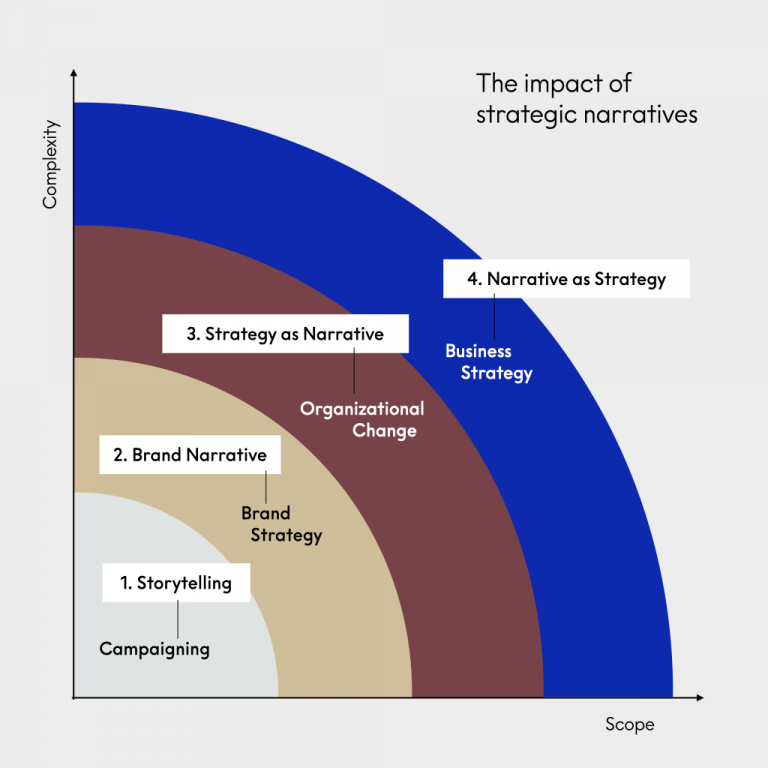
Narrative Strategy — Narratives continue their brilliant career
The topic of narration has fascinated us for over ten years: whether as a management tool, a way of understanding strategy or a means of aestheticization. Since 2012, we at WAALD have been developing strategic narratives for a huge range of actors in business, political and cultural fields.

Download article as whitepaper (PDF)
Listening is also an essential part of our work. In well over 100 hours of interviews (we call the process “story listening”), we heard the most fascinating things about people, branches and business models. Alongside incredible anecdotes, we have uncovered a piece of meta-knowledge:
Different organisations use narratives as a strategic tool in extremely diverse ways - and at the same time, narratives are continuing their brilliant career.
There are different levels of understanding of narratives and their conscious application. We have identified four levels on which narratives come into play. These levels can also be seen as stages of development – the further they are developed, the more vital and valuable the organisation.
1st development stage: Storytelling
At this first stage, the organisation – at least the marketing department – has realised that rather than simply presenting offers by listing product features, they must tell stories. At this stage, narratives are secondary, reduced to an isolated tool necessary for communication, advertising, or as “packaging” – while not only company management and company strategy, but also internal communication and HR, continue to operate separately as before.
As early as the 1980s and 90s when the advertising age reached its peak, this concept resulted in an extreme level of fictionalising in marketing communications. Stories (sometimes utterly absurd fictions) were staged in advertising spots – we can all think of examples. Advertisers assumed that it didn’t really matter what the product was: the emotional narrative was the important thing, then people would buy anything. Unfortunately, this paradigm also resulted in incredibly low-quality products and pseudo-experiences. Above all, it prepared the way for the silo mentality that is still causing great problems today. Company strategy is restricted to the business aspect, while the marketing department independently creates advertising worlds that are in turn isolated from the products. These advertising narratives were and are celebrated by the advertising industry and specialist media as successful “storytelling”. However, we observe that more and more of the companies that are successful in this first development stage shape their marketing communication
around narratives that are fed by what is actually lived and are therefore perceived as authentic.
Use/effectiveness of narratives: at product communication level (campaigns)
2nd development stage: Brand Narrative
At this second stage the company realises that stories must be told not only in product communication, in sales, but that the product portfolio can be aggregated and raised to a higher level. This is known as brand management. Interestingly, military approaches have been and still are applied: for example, “positioning”. The market is seen as a battlefield, where the general stands on higher ground to gain an overview and find the best position for his “troops”. Positioning markers are set that may indeed use semantics but either abbreviate them or concentrate them to such an extent that not much remains of whatever richness the offer provides. Equally, mechanistic models and concepts are often applied that were learnt in business management courses that attempt to imitate science. However, this tends to result in the application of organising principles rather than methods that could actually create valuable meaning. Companies at the second development stage, i.e., companies that understand brands as narratives and work with strategic brand narratives, overcome this disadvantage. Strategic brand narratives are activated by (communicative) action. The brand is not defined and controlled by steering wheels, positioning etc., but is dynamically led by narratives. The narrative explains: what does the brand intend to achieve (its purpose/mission in society as a whole)? What is preventing the brand from achieving this (obstacles, opponents)? The whole narrative stretches across a wide range of communication measures that make the overall brand narrative convincing and bring it to life. It becomes clear that this is not about storytelling as part of an advertising measure, but about an initially abstract story that is given a concrete narrative form by individual communication measures.
This approach is still restricted to marketing, however; the narrative is not yet relevant to other fields of activity in the organisation.
Use/effectiveness of narratives: in marketing/brand management
3rd development stage: Strategy as Narrative
At this stage, organisations realise that everything that they do in marketing is also directly relevant to their own staff. Or to put it another way: they reduce the distance between the narratives the marketing department tells “in the outside world” and those in the “internal all-hands meeting”. This restores the links between the silos in which each functional area was formerly working according to its own logic. Company strategy is translated into narratives that people can understand and relate to. What’s more, narratives create points of contact for participation that are worth far more than undirected participation. Organisations that have reached the third stage have understood: company strategy and business model, market communication and internal communication must be carried out congruently as far as possible. Since an organisation comprises countless narratives, strategic narratives are needed to manage the organisation. If organisations want to evolve, transformation narratives help to drive meaningful change. Because organisations at this development stage realise that they also need to adapt internally in order to achieve change in the whole of society.
Use/effectiveness of narratives: HR, organisational development, company communication, marketing
4th development stage: Narrative as Strategy
This final stage is reached by successful organisations, whether consciously or unconsciously. At this point, the organisation understands that when the entire organisation, the entire business model is managed according to narrative principles, the organisation will achieve success. The “competitive advantage” becomes the “narrative advantage”. The company strategy is more than just an Excel spreadsheet. Strategic narratives become the basis for business models. Every business model needs a narrative check to ensure it is narratable. What’s more, tomorrow’s markets and products are not simply sounded out in calculating and accounting terms; they are developed in such a way that they generate a story. An overall social purpose (purpose narrative) is lived in the venture and every activity is aimed at fulfilling this mission. In this context the organisation perceives itself as a protagonist in a story. Entrepreneurial activity leads to new episodes, twists and exciting moments that make it come alive for people and media.
Internal silos within the organisation merge completely. The staff themselves understand best why they are part of the enterprise and that they are doing their bit in a greater cause. These organisations have a completely different approach to risk management: avoiding risks is the risk.
At this stage, narrative becomes a strategy. The difference to stage 3: strategy isn’t understood as something that must now be translated into a story, but the organisation is understood as the protagonist in a story. The world is the stage. People and media are audience and players.
Use/effectiveness of narratives: Management, R&D and all other areas of the organisation.
How “narrative” is your organisation?